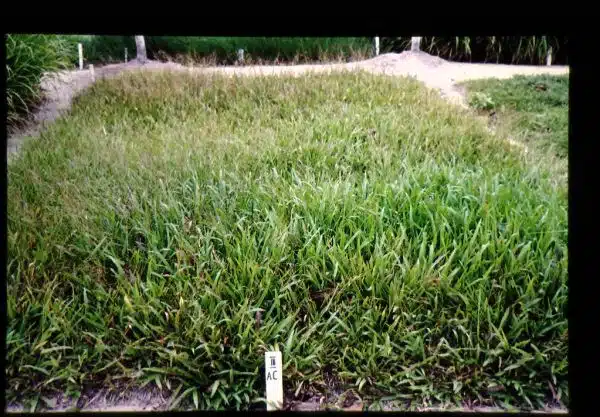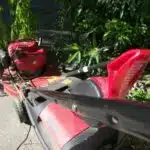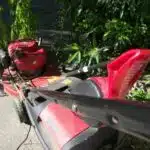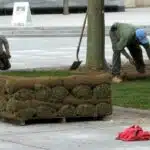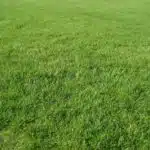Carpetgrass is a warm-season grass that is commonly found in the southeastern United States. It is known for its ability to grow in poor soil conditions, making it a great option for areas where other types of grass struggle to thrive. Carpetgrass is also popular due to its low maintenance requirements and its ability to resist pests and diseases.
Growing and caring for carpetgrass requires some basic knowledge of horticulture principles. In this article, we will provide you with information on how to successfully grow and care for carpetgrass while also helping you understand the benefits of this versatile grass. Whether you are a homeowner looking to improve your lawn or a landscape professional searching for an alternative to traditional turfgrasses, this guide will be an essential resource for your success.
Understanding Carpetgrass: An Overview
As homeowners, we all want a lush green lawn that looks like it belongs on the cover of a magazine. Carpetgrass is one variety of grass that can help us achieve this goal. It is a warm-season grass that grows well in sandy soils and is popular for its low maintenance requirements.
Compared to other types of grass, carpetgrass offers many benefits. It grows well in areas where other grass types struggle, such as poorly drained soil or shady areas. Additionally, carpetgrass requires minimal watering and fertilization, making it an excellent choice for those who want a beautiful lawn without spending too much time or money maintaining it.
If you’re looking for a grass type that doesn’t require frequent mowing, carpetgrass should be your go-to choice. Its slow-growing nature means you only need to mow it once every two weeks during peak growing season. However, if you prefer a golf course-style lawn with shorter blades of grass, then carpetgrass may not be the best fit for you. In the next section, we will discuss how to prepare your soil for optimal carpetgrass growth.
Soil Preparation For Carpetgrass Growth
Carpetgrass is a low-maintenance, heat-tolerant grass that is ideal for use in lawns, parks, and other recreational areas. However, in order to ensure successful growth of carpetgrass, one must start with proper soil preparation. This involves conducting a soil test and making any necessary soil amendments.
Soil testing is an important first step in preparing the soil for carpetgrass growth. This helps determine the pH level of the soil, as well as any nutrient deficiencies or excesses. The results of the soil test will guide you on what type and how much fertilizer to apply to the soil. It is recommended to conduct a soil test at least once every 3 years to monitor changes in pH levels and nutrient availability.
Once you have received the results of your soil test, it is time to make any necessary soil amendments. These can include adding lime to raise pH levels or sulfur to lower them, as well as adding organic matter such as compost or peat moss to improve soil structure and water retention. It is important to follow the recommended rates for each amendment and avoid over-applying fertilizers or other products that may harm the environment. With proper soil preparation, your carpetgrass will have a healthy foundation for growth and development.
Transition: While proper soil preparation is essential for growing healthy carpetgrass, choosing the right variety for your region is equally important.
Choosing The Right Carpetgrass Variety For Your Region
While there are many different varieties of carpetgrass available to choose from, it’s important to select the right one for your particular region. This is because not all types of carpetgrass will be able to thrive in every climate or soil type. Some may be more suited for areas with high rainfall, while others may be better adapted to drought-prone regions.
When making your carpetgrass variety selection, it’s important to consider factors such as regional carpetgrass adaptation and the specific needs of your lawn or landscaping project. For example, if you live in a humid area with frequent rainfall, you may want to choose a variety that is more resistant to disease and can tolerate wet conditions. Conversely, if you live in a dry region with limited water resources, you may want to select a variety that is drought-resistant and can withstand periods of extended heat.
Ultimately, selecting the right carpetgrass variety is crucial for ensuring that your lawn or landscaping project thrives over time. By taking into account factors such as regional adaptation and specific environmental conditions, you can make an informed decision about which type of carpetgrass will work best for your needs. In the next section, we’ll discuss another important aspect of growing healthy carpetgrass: deciding whether to plant seeds or sod.
Planting Carpetgrass: Seeds Vs. Sod
When it comes to planting carpetgrass, you have two options: seeds or sod installation. Seed germination is a less expensive option and is ideal for those who want to cover a large area of land. However, it requires patience as the grass takes longer to establish. In contrast, sod installation provides an instant carpet of lush greenery but can be more costly than seeds.
If you opt for seed germination, prepare the soil by removing debris and weeds that may hinder growth. The best time to sow carpetgrass seeds is during the spring or fall when temperatures range from 70-85°F. After sowing the seeds, lightly rake them into the soil and water regularly to keep the soil moist until germination occurs.
Sod installation is a quicker method of planting carpetgrass. To ensure successful establishment, prepare the soil by removing debris and weeds and leveling any uneven areas. You should install sod during mild weather conditions when temperatures range from 60-75°F. Once installed, water your new lawn daily for at least two weeks to help roots grow deep into the soil.
Overall, both methods have their advantages and disadvantages depending on what you are looking for in terms of cost and time frame for establishment. However, regardless of which method you choose, proper care must follow after planting to ensure healthy growth and development of your new carpetgrass lawn.
The next crucial step after planting your carpetgrass lawn is watering it properly to facilitate root growth and prevent drying out. Understanding how often and how much water your carpetgrass needs will help maintain its health and lush appearance over time; this will be discussed in detail in the subsequent section about “watering carpetgrass: frequency and amount.”
Watering Carpetgrass: Frequency And Amount
Watering is a crucial aspect of carpetgrass care. Adequate watering facilitates healthy growth and development, while insufficient watering can lead to stunted growth and even death. The frequency of watering depends on several factors, including the climate, the soil type, and the age of the grass. In general, newly planted carpetgrass requires more frequent watering than established grass.
Watering frequency should be determined by monitoring the moisture level in the soil. This can be done by inserting a probe or stick into the soil to check for dampness. If the soil feels dry to the touch, it is time to water your carpetgrass. During hot and dry weather conditions, carpetgrass may require daily watering to keep it hydrated. However, during cooler months or periods with consistent rainfall, less frequent watering may be necessary.
The amount of water required for carpetgrass varies depending on several factors as well, such as temperature and humidity levels in your area. As a general rule of thumb, carpetgrass requires about 1 inch of water per week. However, this amount may need adjustment based on local climate conditions and other factors that could impact plant growth. To ensure optimal growth and development for your carpetgrass lawn, make sure you are providing adequate amounts of water at regular intervals throughout the growing season.
Moving forward from proper watering practices for your Carpet Grass lawn; fertilizing is also an essential process for maintaining optimal growth and development. By following the right fertilizing techniques, you can help boost your lawn’s health while keeping its lush green color all year round.
Fertilizing Carpetgrass For Optimal Growth
Carpetgrass is a low-maintenance turfgrass that can thrive in warm and humid environments. To promote optimal growth, it is important to fertilize the grass appropriately. When considering fertilizers, organic options are recommended as they provide a slow release of nutrients over time and improve soil health. Timing strategies for fertilizing carpetgrass include applying fertilizer during the growing season, avoiding application during droughts or extreme heat, and spreading fertilizer evenly to avoid uneven growth.
When selecting an organic fertilizer for your carpetgrass lawn, there are several options available. Compost is a popular choice as it enriches soil with microorganisms and nutrients such as nitrogen and phosphorus. Another option is using animal manure such as cow or horse manure which provides essential nutrients while also improving soil texture. In addition, there are many commercial organic fertilizers on the market that are formulated specifically for turfgrasses.
Timing strategies for fertilizing carpetgrass are crucial to ensure the grass receives the necessary nutrients at the right time. Applying fertilizer during the growing season promotes healthy root development and overall plant health. Fertilizer should not be applied during periods of drought or extreme heat as this can cause damage to the grass roots. Lastly, it is important to spread fertilizer evenly across the lawn to avoid uneven growth which can result in unsightly patches.
In summary, choosing an appropriate organic fertilizer and timing its application correctly are both essential components in promoting optimal growth of carpetgrass. By utilizing these strategies, your lawn will flourish with healthy roots and lush green foliage. The next step in maintaining a healthy carpetgrass lawn is by following best practices for mowing which will be discussed in detail in the subsequent section on mowing carpetgrass: best practices.
Mowing Carpetgrass: Best Practices
To ensure that your carpetgrass remains healthy and lush, mowing is essential. Mowing helps to keep the grass at a uniform height, which in turn promotes even growth and prevents weeds from taking over. The frequency of mowing will depend on your climate, soil type, and the amount of rainfall your area receives.
In general, you should aim to mow your carpetgrass every 7-10 days during the growing season. If you have sandy soil or live in a hot, dry climate, you may need to increase the frequency of mowing to prevent the grass from becoming too tall and falling over. On the other hand, if you have clay soil or live in a cooler region with more rainfall, you may be able to get away with mowing less frequently.
When it comes to choosing equipment for mowing your carpetgrass, there are several options available. Push reel mowers are an eco-friendly choice that produces no emissions and requires no fuel or electricity. However, they may not be suitable for larger lawns or thick patches of grass. Gas-powered lawn mowers are a popular option due to their power and flexibility, but they do produce emissions and require regular maintenance. Electric mowers are another option that produces fewer emissions than gas-powered models but may not have enough power for larger lawns.
As you can see, keeping your carpetgrass healthy involves more than just fertilizing and watering it properly. By following best practices for mowing frequency and equipment selection, you can help ensure that your lawn stays lush and green throughout the growing season. In the next section, we will discuss some common pests and diseases that can affect carpetgrass and how to deal with them effectively.
Dealing With Common Carpetgrass Pests And Diseases
Carpetgrass is a resilient turfgrass that can withstand various environmental conditions. However, like other plants, carpetgrass can be susceptible to pests and diseases. In fact, according to a study conducted by the University of Florida, the most common pests found in carpetgrass lawns are armyworms and chinch bugs. These pests can cause significant damage to your lawn if left unattended.
Preventing infestations is one of the best ways to protect your carpetgrass from potential pest damage. Regularly inspecting your lawn for signs of insect activity, such as chewed blades or brown patches, can help you detect infestations early on. Additionally, maintaining proper lawn care practices such as mowing at the correct height and watering deeply but infrequently can also deter pest activity.
Treating fungal infections is another important aspect of caring for your carpetgrass lawn. Fungal diseases such as brown patch and dollar spot can cause unsightly browning and thinning of the grass blades. To prevent fungal infections, avoid over-watering your lawn and ensure proper drainage. If a fungal infection does occur, fungicides can be applied to control its spread. It is important to follow label instructions carefully when using fungicides to ensure their effectiveness and safety.
In conclusion, preventing pest infestations and treating fungal infections are two key components in maintaining a healthy carpetgrass lawn. By being vigilant in monitoring your lawn’s health and following proper care practices, you can prevent potential damage caused by these issues. The next section will discuss weed control in carpetgrass lawns, another important aspect of maintaining a lush green yard.
Weed Control In Carpetgrass Lawns
Carpetgrass is known for its ability to grow in poor soil conditions and tolerate heat and drought. However, it is not immune to weed infestations. Weeds can quickly take over a carpetgrass lawn if left unchecked, so it is important to implement effective weed control strategies.
Mulching techniques are an excellent way to prevent weed growth in carpetgrass lawns. Mulch acts as a barrier that inhibits the growth of weeds by blocking sunlight and preventing seeds from germinating. Organic mulches such as grass clippings, leaves, or pine needles are ideal for this purpose. They not only suppress weed growth but also provide nutrients to the soil as they decompose.
If chemical-free alternatives are preferred, hand-weeding or using a hoe can be effective methods of removing weeds from carpetgrass lawns. These methods require more effort and time than chemical herbicides, but they are safer for the environment and do not harm beneficial insects or wildlife. The key is to remove weeds before they have a chance to spread their seeds and create more problems.
In summary, maintaining a weed-free carpetgrass lawn requires vigilance and consistent effort. Mulching techniques and chemical-free alternatives such as hand-weeding or using a hoe can effectively control weeds without damaging the environment. In the next section, we will discuss how aerating and dethatching carpetgrass lawns can help promote healthy growth and prevent future weed infestations.
Aerating And Dethatching Carpetgrass Lawns
Aerating and dethatching are essential steps in lawn maintenance for carpetgrass. These processes improve air and water circulation within the soil, allowing for better nutrient absorption by the roots. Additionally, aerating and dethatching can help reduce soil compaction and thatch buildup, which can lead to a healthier lawn overall.
To aerate a carpetgrass lawn, use an aerator machine or manual tool to create small holes throughout the soil. This should be done when the soil is moist but not overly wet, ideally during the growing season. Afterward, it’s recommended to fertilize and water the lawn to ensure optimal growth.
Dethatching involves removing dead grass and other organic material that accumulates on top of the soil over time. This process is typically done with a specialized rake or power tool designed for dethatching. Regular dethatching can help prevent thatch buildup, which can suffocate grass roots and impede healthy growth. Overall, incorporating these yard care practices into your routine can lead to a lush, healthy carpetgrass lawn that thrives year-round.
- Regularly aerate your carpetgrass lawn to promote healthy root growth.
- Use a specialized rake or power tool to dethatch your lawn regularly.
- Fertilize and water your lawn after aerating to ensure optimal growth.
As you work towards maintaining your dream yard with beautiful carpetgrass coverage, it’s important to consider overseeding as part of your strategy. By overseeding regularly, you can fill in bare spots while promoting thicker coverage throughout your entire lawn area. In our next section, we’ll explore how overseeding carpetgrass can provide you with fuller coverage all year long.
Overseeding Carpetgrass For Fuller Coverage
Looking for a way to achieve a fuller carpetgrass coverage? Overseeding is one of the most effective methods for achieving this goal. This technique involves spreading additional grass seed over an existing lawn, which allows for the growth of new blades alongside the existing ones, filling in any bare spots.
To start, you’ll need to choose the best time to overseed your carpetgrass lawn. Generally speaking, it’s best to do this during the fall season when temperatures are cooler and there is more rainfall. The combination of cooler temperatures and consistent moisture helps promote optimal seed germination rates.
There are various overseeding techniques you can use depending on your preferences and available resources. One common method is broadcasting, which entails spreading seeds evenly across the entire lawn with a broadcast spreader. Another technique is slit-seeding, where a specialized machine cuts shallow furrows into the soil before depositing seeds within them. Regardless of which method you choose, make sure to water your lawn frequently throughout the overseeding process until new growth appears.
When it comes to maintaining a lush carpetgrass lawn, overseeding can be an invaluable tool. By carefully selecting the right time to perform this technique and using proper seeding methods, you can ensure that your lawn remains healthy and full throughout the year. In our next section, we’ll discuss how to prepare your carpetgrass for winter by winterizing it properly.
Winterizing Your Carpetgrass Lawn
After overseeding your carpetgrass lawn, it is important to prepare it for the upcoming winter season. Maintaining a healthy lawn during winter requires some extra care and attention. Winter lawn care involves protecting the roots of the grass from harsh weather conditions such as frost, snow, and extreme cold.
One way to protect the roots of your carpetgrass is by mowing it shorter than usual in late fall. This helps prevent snow mold from developing while allowing enough leaf surface for photosynthesis. Additionally, it is crucial to keep your lawn free of debris and fallen leaves. This can be achieved by raking or using a leaf blower regularly.
Watering is also an essential aspect of winter lawn care. It is recommended to water your carpetgrass deeply once every three weeks, depending on the weather conditions in your area. Overwatering can cause damage to the roots of the grass, so be sure not to overdo it.
- Ensure that all garden tools are properly stored away after use.
- Hire a professional landscaper for regular maintenance.
- Make sure that pets do not dig holes or run around on the lawn.
- Use fertilizers sparingly and avoid applying them during colder months.
- Remove weeds as soon as you spot them to prevent further growth.
In conclusion, taking good care of your carpetgrass lawn during winter will help ensure its health and beauty come springtime. By following these tips and maintaining a consistent watering schedule, you can protect your grass from harsh weather conditions and maintain its lush appearance throughout winter. Next up: maintaining carpetgrass in high traffic areas.
Maintaining Carpetgrass In High Traffic Areas
Maintaining carpetgrass in high traffic areas can be a challenging task, but it is essential to ensure the longevity and aesthetic appeal of your lawn. Preventing compaction is the first step in maintaining carpetgrass in high traffic areas. This can be achieved by regularly aerating the soil to allow air, water, and nutrients to penetrate deep into the roots. Compacted soil can lead to shallow root systems, which will increase the likelihood of damage from foot traffic.
Using protective coverings is another effective way to maintain carpetgrass in high traffic areas. Coverings such as mulch or gravel act as a cushion between foot traffic and the grass blades, reducing wear and tear. It is important to note that these coverings should not completely smother the grass blades as this can lead to suffocation and an unhealthy lawn.
Regular maintenance is crucial when it comes to preserving the beauty of your carpetgrass lawn. By following these simple steps, you can ensure that your grass remains healthy, even in high traffic areas. However, if you notice any issues with your carpetgrass lawn, it is important to troubleshoot common problems promptly.
Troubleshooting Common Carpetgrass Issues
Maintaining carpetgrass in high traffic areas can be challenging, but with proper care and attention, it is possible to keep your lawn looking healthy and lush. However, even the most well-cared for carpetgrass lawns may experience common problems that require troubleshooting.
One of the most common carpetgrass problems is weed invasion. Weeds can quickly take over a lawn and compete with the grass for nutrients, water, and sunlight. To prevent weeds from taking hold in your carpetgrass lawn, it’s important to maintain regular mowing and watering schedules. Additionally, you may want to consider applying pre-emergent herbicides to prevent weed seeds from germinating.
Another issue that may arise with carpetgrass lawns is fungal diseases. Fungal diseases can cause brown patches or spots on the grass blades and often occur when there is too much moisture present in the soil. To prevent fungal diseases from taking hold in your lawn, ensure that your soil has proper drainage and avoid overwatering your grass. If a fungal disease does occur, you may need to apply fungicides or remove the affected areas of grass.
In summary, caring for a carpetgrass lawn requires consistent effort and attention to detail. Common carpetgrass problems such as weed invasion and fungal diseases can be prevented with proper maintenance techniques such as regular mowing, watering schedules, pre-emergent herbicide application, proper drainage measures, and timely treatment with fungicides or removal of affected areas of grass. By following these troubleshooting tips, you can achieve a healthy and lush carpetgrass lawn that will be the envy of your neighbors! In the subsequent section about tips for a lush healthy carpetgrass lawn we will explore additional techniques for optimal growth of this beautiful turf grass species.
Tips For A Lush, Healthy Carpetgrass Lawn
Did you know that a well-maintained lawn can increase the value of your property by up to 20%? This is why it’s important to ensure that your carpetgrass lawn is lush and healthy. Achieving this requires some effort and dedication, but it’s definitely worth it in the end.
One way to ensure that your carpetgrass lawn looks neat and tidy is by using lawn edging. This technique involves creating borders around the edges of your lawn to separate it from other areas of your yard, such as flower beds or walkways. Lawn edging not only makes your lawn look more attractive, but it also helps to prevent grass from spreading into unwanted areas.
Another way to promote a healthy carpetgrass lawn is by using mulching techniques. Mulch can help to retain moisture in the soil, prevent weed growth, and regulate soil temperature. When using mulch on your carpetgrass lawn, make sure that you don’t apply too much as this can suffocate the grass. A layer of 2-3 inches should be enough to provide the benefits of mulching without causing harm.
Maintaining a lush and healthy carpetgrass lawn requires effort and attention to detail, but with the right techniques, you can achieve amazing results. By incorporating lawn edging and mulching techniques into your routine maintenance schedule, you’ll have a beautiful lawn that will enhance the value of your property for years to come. Remember that caring for your carpetgrass lawn is not just about aesthetics; it’s about creating an inviting space where you can relax and enjoy nature at its best.
Conclusion
Carpetgrass is a low-maintenance turfgrass that is well-suited for warm, humid climates. To ensure successful growth and maintenance of your carpetgrass lawn, it is essential to understand the basics of soil preparation, variety selection, planting methods, watering practices, winterization techniques, and troubleshooting common issues.
Proper soil preparation is crucial for carpetgrass growth. It requires a slightly acidic soil with good drainage and adequate organic matter content. Choosing the right variety for your region is also important since different varieties have varying tolerances to environmental conditions such as drought or shade. Planting can be done through seeds or sods depending on your preference and availability. Adequate watering should be carried out during dry spells but care must be taken not to overwater as this may lead to fungal infections.
It is equally important to maintain a healthy carpetgrass lawn in high traffic areas by regularly mowing at the correct height and avoiding compaction from foot or vehicular traffic. Winterizing your lawn by fertilizing with a slow-release fertilizer will ensure it remains lush throughout the season. Finally, in case of any issues such as pest infestations or discoloration, proper diagnosis and treatment should be sought from professionals. With these tips in mind and proper care, you can achieve a healthy and vibrant carpetgrass lawn that will be the envy of all who see it.
Image Credits
- “Carpetgrass = カーペットグラス” by JIRCAS (featured)

